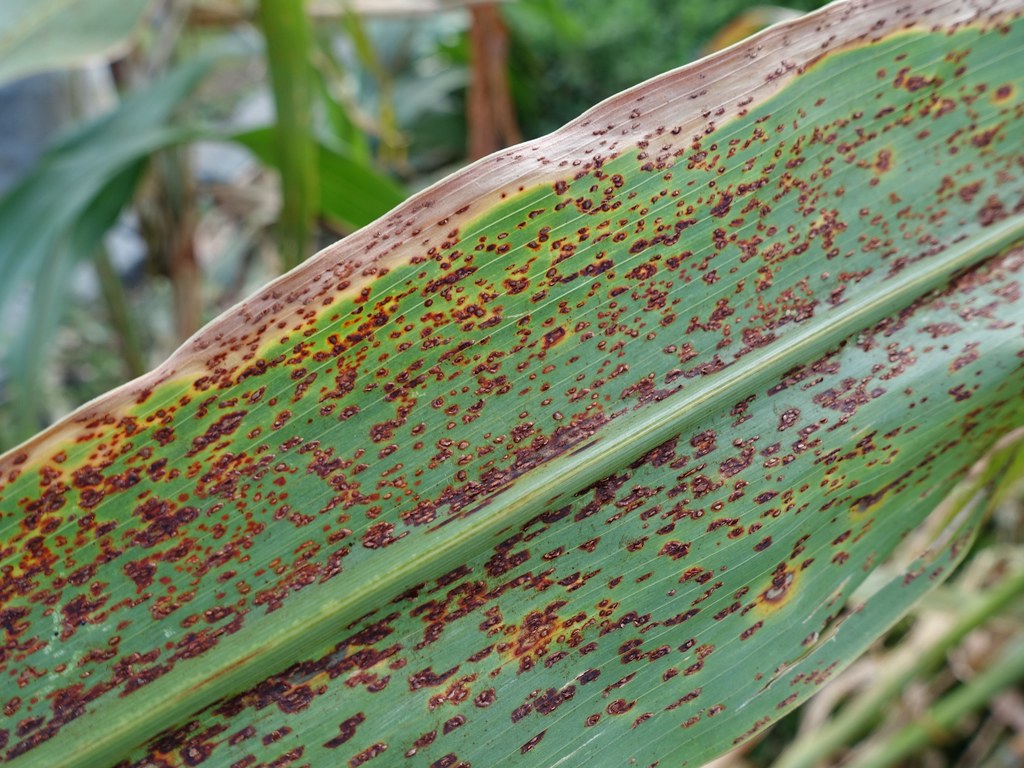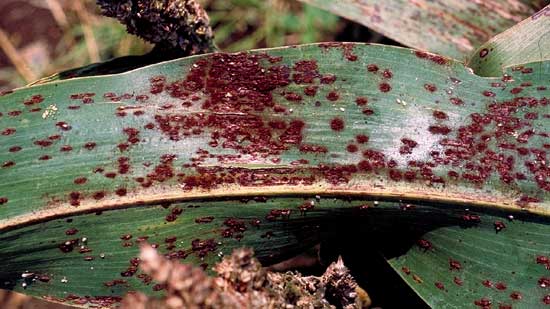Rust of sorghum is a fungal disease caused by Puccinia purpurea. It primarily affects sorghum plants by creating circular to oval purplish pustules on the lower surface of leaves. These pustules start as tiny flecks and gradually develop into visible structures.
The disease is more prominent in mature plants, typically around 1.5 to 3 months old. In India, sorghum rust has been observed to impact susceptible sorghum varieties. Under cool and humid conditions, rust infection can lead to the premature death of foliage, which adversely affects grain yield.
The fungus responsible for sorghum rust, Puccinia purpurea, doesn’t survive for long in soil or infected debris. Instead, it needs to spend the winter in other hosts, like certain grasses or weeds including the creeping woodsorrel (Oxalis corniculata). The spores of this fungus can travel long distances with the help of wind and rain.
The disease develops more when the conditions are right. This includes high humidity (almost 100%), dew, rain, and cooler temperatures (around 10-12 °C). On the other hand, hot and dry weather slows down the fungus’s growth and the spread of the disease. In severe cases, the leaves that are heavily infected might wither and even get destroyed.
Rust of Sorghum Symptoms:

Sorghum rust can affect sorghum crops at various stages of growth, showing distinct signs and effects. Here are the key symptoms to look for:
- Initial Signs: The first signs of rust infection appear as small purple-red or tan spots on the upper and lower surfaces of lower leaves.
- Pustule Formation: These spots grow into raised pustules that eventually burst, releasing reddish-brown spores. These pustules can spread to all leaves, as well as leaf sheaths and stems.
- Pustule Shape: The pustules take on an elliptical shape that aligns with the leaf veins.
- Spread Mechanism: Rust spores are easily carried over long distances by wind and rain. The pathogen survives during off-seasons on infected crop debris and on other plants like Johnson grass.
- Dense Infection: Highly susceptible cultivars might experience such dense pustule growth that it leads to the destruction of almost the entire leaf tissue.
- Fleck Formation: Young plants usually escape rust infection. Visible symptoms typically emerge in plants aged 1.5 to 3 months. Flecks of purple, red, or tan appear on leaf surfaces, but in resistant cultivars, these symptoms don’t progress further.
- Pustules on Leaves: Susceptible cultivars develop typical rust pustules, especially on the lower leaf surfaces. When touched, these leaves can leave a reddish powder residue on fingers.
- Inflorescence and Sheath Pustules: Pustules may also form on leaf sheaths and inflorescence stalks.
- Time of Occurrence: Symptoms are often seen in plants aged 1-1.5 months. Small flecks of different colors emerge on lower leaves. For resistant varieties, the symptoms usually stop at this stage. In susceptible types, these flecks transform into powdery, purplish pustules that can be circular or elongated. In severe cases, they can cover the entire plant, causing infected fields to appear brown.
Remember that rust is a fungal disease that can have significant impacts on sorghum crops, affecting their growth and overall health. Monitoring and managing rust outbreaks are essential to ensure successful sorghum cultivation.
Also Read: Long Smut of Sorghum: Symptom, Disease Cycle, and Management
Impact and Favorable Conditions for Sorghum Rust Outbreaks
Impact:
Sorghum rust outbreaks usually happen later in the season, during the grain-filling phase. These outbreaks typically result in minor yield losses. However, there’s a possibility of disease occurring earlier in the season, especially when the crop encounters cool and wet weather.
If infection takes place before anthesis (the flowering stage), susceptible sorghum varieties could experience yield reductions of up to 13% (White et al. 2012). The disease’s severity increases when there’s high relative humidity, frequent heavy dews, rain, and cooler temperatures.
Moreover sorghum rust might make the crop more susceptible to other diseases like charcoal rot.
Favorable Conditions for Outbreaks:
Sorghum rust outbreaks are favored by specific conditions:
- Late Season: Outbreaks typically happen later in the growing season, particularly during grain-filling.
- Early Season: Cool and wet periods earlier in the season can trigger outbreaks before the grain-filling phase.
- Temperature and Humidity: Cooler temperatures, high relative humidity, and heavy dews create a suitable environment for rust development.
- Rainfall: Frequent rain aids in spreading the disease, as the spores can be carried to new plants.
- Yield Impact: Infection before flowering can lead to yield reductions, especially in susceptible sorghum varieties.
- Other Diseases: Sorghum rust might increase the crop’s vulnerability to other diseases like charcoal rot.
Also Read: Covered Kernel Smut Sorghum: Symptoms, Management
Rust of Sorghum Management:
Preventing Method:
Izumonas-Best Fungicide
Contents: Pseudomonas Fluorescens
IZUMONAS is a biological product consisting of plant growth-promoting rhizobacteria (PGPR), which are naturally occurring bacteria found widely in nature. This unique product is designed to enhance plant defence mechanisms and promote healthy growth. IZUMONAS can be used on all types of crops without leaving any residue on the plants.
Izumil-Best Fungicide
Contents:
- Extract of Streptomyces griseus: 30%
- Extract of Streptomyces violaceus: 40%
- Dissolving agents: 30%
IZUMIL is a remarkable biotech research product that has been developed to activate the natural defence mechanism of plants. By using IZUMIL, plants can better protect themselves against fungal pathogens, improve their physiological functions, and develop resistance against various harmful microorganisms. Similar to IZUMONAS, IZUMIL can be safely used on all crops without leaving any residue.
Modes of Use:
- Seed Treatment: Mix 5-10 ml of IZUMONAS and IZUMIL per kilogram of seeds in an adequate amount of water. Submerge the seeds in this solution and allow them to dry in a shaded area before sowing.
- Seedling Treatment: Combine 100 ml of IZUMONAS and IZUMIL per 20 litres of water. Dip the roots of the seedlings in this solution for approximately 30 minutes prior to transplanting.
- Soil Application: Mix 500 ml of IZUMONAS and IZUMIL with 30 kilograms of farmyard manure (FYM) or soil. Apply this mixture to one acre of land before ploughing or irrigation.
- Foliar Application: Dilute 2-3 ml of IZUMONAS and IZUMIL each in 1 litre of water. Use this solution to spray the entire foliage of the plants, ensuring complete coverage on both sides of the leaves. It is advisable to shake the bottle before use. For best results, spray early in the morning or evening. If a power sprayer is used, double the recommended dosage.
Cultural Method
- Choose Sorghum Varieties Resistant to Rust:
- Pick sorghum types that are naturally more resistant to rust.
- Look for varieties that are known to perform well in your local area.
- Opt for Healthy Certified Seeds:
- Use seeds that come from a trusted and certified source.
- Avoid using seeds from fields that show signs of infection.
- Early Planting for Disease Prevention:
- Plant sorghum early in the growing season.
- This helps to avoid the ideal conditions for rust infection to develop.
- Consider Shorter Season Varieties:
- Choose sorghum varieties that have a shorter growth cycle.
- These varieties mature earlier, reducing the exposure time to rust.
- Vigilant Field Monitoring:
- Regularly inspect your sorghum field for any signs of rust disease.
- Be on the lookout for characteristic rust-colored lesions on leaves.
- Prompt Removal of Infected Plants:
- If you find plants with rust symptoms, remove them immediately.
- Destroy these infected plants, for example, by burning them.
- Effective Weed Management:
- Implement a robust weed control strategy in your field.
- Proper weed management helps prevent the spread of rust and other diseases.
- Crop Rotation with Non-Susceptible Plants:
- Rotate your sorghum crop with plants that are not susceptible to rust.
- This breaks the disease cycle and reduces the chance of infection.
Also Read: Downy Mildew of Sorghum: Symptoms, Disease Cycle, Management

